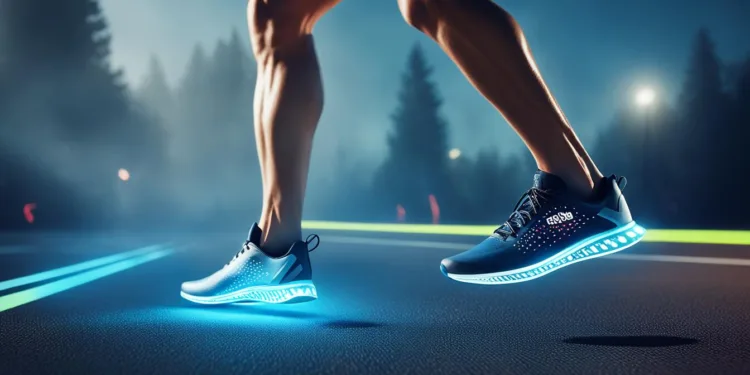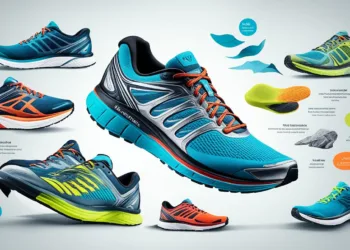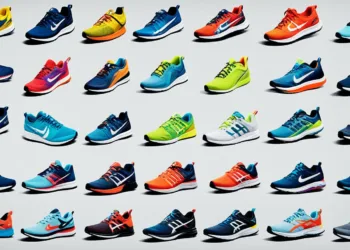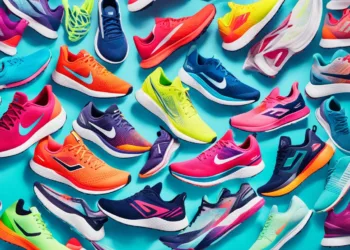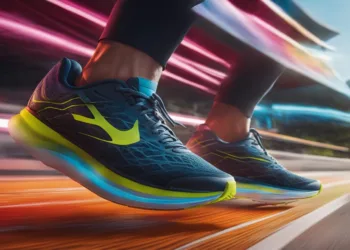Table of Contents
- 1 The Evolution of Running Shoes: From Rubber Soles to Smart Technology
- 2 Running Shoes with Smart Features: Enhancing Your Performance
- 3 Innovations in Smart Running Footwear
- 4 Utilizing Wearable Technology in Running Footwear
- 5 Running Shoes Smart Features: Which Smart Capabilities Do Today’s Runners Need?
- 6 Running Shoes and Wearable Tech Trends: What’s Next on the Horizon?
Have you ever wondered what it would be like to have a high-tech brain in your running shoes? Welcome to the era of Running Shoes Smart Features.
The capabilities of these innovative Smart Running Shoes extend far beyond comfort and style. They are equipped with technology that takes your running experience to a whole new level. Bluetooth-connected insoles link to smartphone apps, tracking your fitness data, providing personalized feedback, and even evaluating health metrics.
The likes of Nike and Under Armour, with their respective shoes – HyperAdapt 1.0, HOVR Phantom and Sonic – are leading this technological revolution. Other brands such as Digitsole, Xiaomi, and Altra Torin IQ are not far behind, each integrating their own unique Running Shoes with Tech Features.
While the smart shoe market is still in its nascent stage, it is expected to witness significant growth by 2022. Major industry players are investing in advanced features, biomechanically customized shoes, and injury prevention technologies to cater to the evolving needs of runners worldwide. While challenges persist, the future of running shoes has never looked smarter!
key takeaways:
- Evolution of Running Shoes: From Simplicity to Smart Tech
- Smart Features in Running Shoes: Performance Enhancers
- Innovations: The Future of Running Footwear
- Wearable Tech in Footwear: A Game Changer
- Smart Capabilities: Meeting Today’s Runner’s Needs
- Future Trends: What’s Next for Running Shoes
The Evolution of Running Shoes: From Rubber Soles to Smart Technology
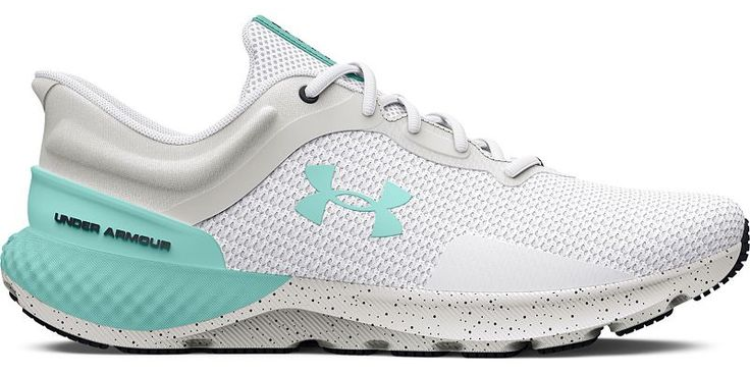
The journey of running shoes has been epic. Beginning with the basics of rubber soles providing merely the essential protection and traction, the shift towards incorporating intelligent and intricate mechanisms has revolutionised. The evolution of running shoes remarkably emphasizes the expansion of Wearable Technology in Running Footwear.
Technological progress has fostered the integration of various sensors into footwear. For instance, the incorporation of gait analysis sensors, GPS for real-time location tracking, pressure sensors, and other environment-friendly sensors are indicative of the times we are living in – the era of smart wearables and footwear.
A few exemplifications of these advancements consist of revolutionary self-lacing shoes like Nike’s HyperAdapt, Running Shoes and Wearable Tech Trends have also ushered in Under Armour’s sensor-packed HOVR series that sync beautifully with the Map My Run app, and Digitsole’s interactive shoes exhibiting auto-lacing and temperature regulation features.
- Nike’s HyperAdapt revolutionizes shoe-fit with its self-lacing mechanism that requires no physical adjustment.
- Under Armour’s sensor-packed HOVR series incorporates smart sensor technology, providing reliable tracking measures that sync with the Map My Run app.
- Digitsole’s interactive shoes take personal comfort to the next level with their auto-lacing and temperature regulation features.
Additionally, industry movers and shakers have been significantly focused on reimagining and revamping running footwear. Take the example of VF Corporation’s acquisition of Altra Footwear. This acquisition underlines the shift towards creating data-rich, sophisticated, and comprehensive running shoes.
Moreover, collaborative projects between different brands are taking centre stage, too. The amalgamation between Puma and MIT Design Lab signifies the leaps the industry is making. It emphasizes the relentless efforts to refine, redefine, and rethink the concept of running shoes and display more than just flashy tags. Instead, these shoes showcase innovative, bright elements that profoundly enhance the running experience, making it a detailed, informative endeavour beyond mere physical activity.
“read also: Running Shoes for Marathon“
Running Shoes with Smart Features: Enhancing Your Performance
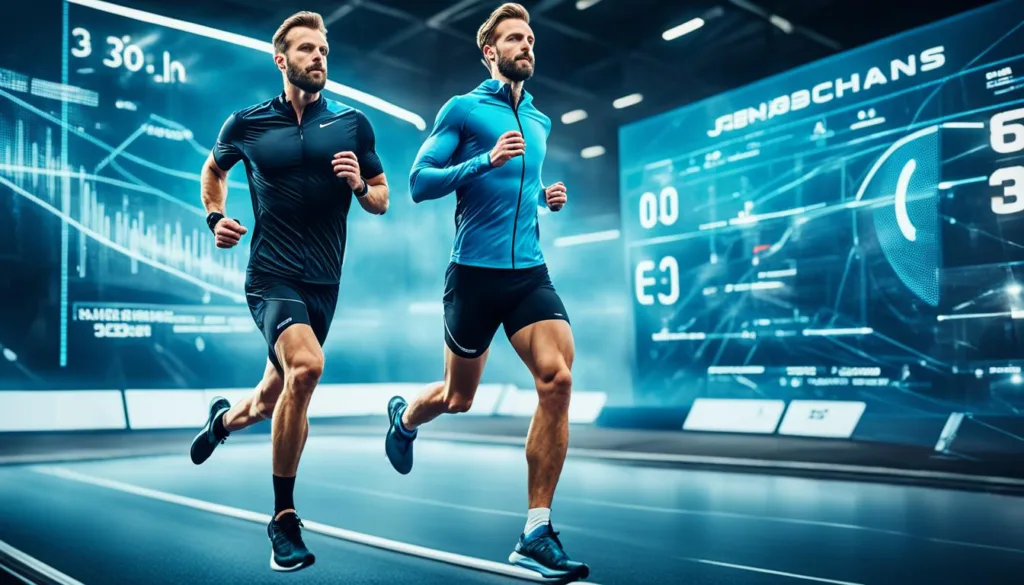
The era of smart running shoes has ushered in a revolution in athleticism, where digital technology contributes seamlessly to improved running efficiency. Running Shoes with Smart Capabilities are poised at the forefront of personalizing athletic performance, leveraging Technological Enhancements in Running Shoes. These enhancements span a range of features, from smart sensors and real-time data transmission capabilities to the innovative deployment of gyroscopes and accelerometers in run analysis.
Smart Sensors and Real-Time Data Transmission
Smart running shoes employ various sensory technologies to optimize the runner’s experience. These include accelerometers, gyroscopes, and magnetometers, which collaborate to accomplish a detailed gait analysis. Moreover, the integration of satellite systems, such as GPS, GLONASS, and GALILEO, grants precise positioning data. Pressure sensors reveal pertinent information about body weight distribution, while environmental sensors record changes in elevation and surroundings. The internal status sensors ensure constant monitoring of battery and memory capacity. Ultimately, these features collaborate to enhance runs with technology, offering a visual representation of your athletic performance.
Impact of Gyroscopes and Accelerometers on Run Analysis
Gyroscopes and accelerometers, fundamental components of smart running shoes, yield significant benefits for run analysis. Precisely, the gyroscopic sensors are adept at evaluating the orientation and angular rotational movement during the run, while the accelerometers track speed and movement across dimensions. This rich array of data enables a comprehensive evaluation of the stride, foot-landing zone, and overall running style. These insights can pave the way to appropriate adjustments in running techniques, ensuring increased speed and reduced risk of injuries, thus marking the dawn of Smart Running Shoe Developments.
Innovative Shoe Technologies for Adaptive Comfort
Smart running shoes aren’t limited to data analytics; they go further with adaptive comfort. They include auto-lacing systems designed to provide a customized fit, thereby minimizing injury risks linked with poorly fitted shoes. Innovations in smart running footwear like Altra Torin IQ possess lightweight sensors, while Digitsole has introduced temperature regulation. These are tailored to suit individual comfort levels, reacting to temperature fluctuations and cushioning requirements in real time. Intelligent Features are a particular highlight in running shoes from Under Armour’s HOVR series, which deliver a sensation of zero gravity and energy return, thus exemplifying how technology can refine comfort and performance in running shoes.
“read also: Running Shoes Puma“
Innovations in Smart Running Footwear
The digital revolution transcends to the arena of performance wear, more specifically, running shoes. As the market for running shoes with smart capabilities continues to burgeon, it’s fairly intriguing to delve deeper into the emerging technology enhancements within this segment, made possible by the notable trailblazers and emerging startups, and the symbiotic relationship between aesthetics and functionality in footwear design.
Leading Brands and Emerging Startups in the Smart Shoe Industry
Nike’s E.A.R.L. self-lacing technology, Under Armour’s connected sneakers, and Xiaomi’s Mijia Smart Shoes show how established brands are innovating with impressive tech features within the smart running shoe industry. Yet, the field is not exclusive to the big players. Startups like FeetMe with its medical-grade sensor technology, 3L Labs’ FootLogger focused on detecting health problems, and E-vone with its fall-detection capabilities, not only diversify the smart shoe landscape but crucially drive the evolution of this segment.
Technology Meets Design: Style and Smart Functionality
The intertwining of fashionable designs with ground-breaking technology is transforming the smart running shoe industry. Brands aim to meet consumer demand for shoes that sport great aesthetics and innovative tech features. Take, for example, Digitsole’s smart shoes, which combine activity tracking and a heating system with a trendsetting tightening technology. Similarly, Nike’s self-lacing HyperAdapt and Under Armour’s HOVR series balance attractive visual appeal with innovative tech features, proving that style and smart functionality must go hand in hand for an enhanced running experience.
“read also: Running Shoes for Trail Running“
Utilizing Wearable Technology in Running Footwear
Wearable technology no longer just adorns your wrist—it’s made its way to your feet. Running Shoes with Smart Capabilities are increasingly benefiting from advancements in wearable technology, with a focus on embedding sensors directly where the user’s interaction with the environment happens – at the feet.
This approach covers the blind spot of traditional fitness trackers by capturing stride, cadence, and ground impact data that wrist-worn devices often miss. These innovations showcase the potential for wearable technology in running footwear to play a pivotal role in optimizing fitness routines and responding to specific athletic and health needs.
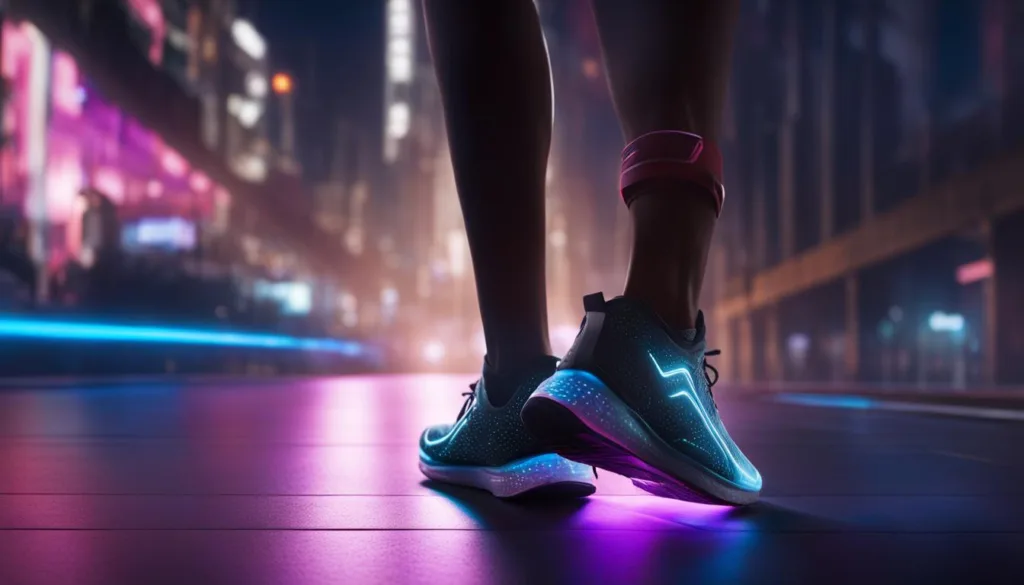
Products such as the collaborative effort between Google, adidas, and EA Sports are a clear indication of the advancements in this sector. These smart shoes provide detailed analytics that not only enhance training and performance but also contribute to comprehensive health monitoring.
| Brand | Product | Key Features |
|---|---|---|
| Under Armour | HOVR Series | Embedded sensors offer feedback on running metrics to inform training routines and strategies. |
| Nike | Adapt BB | Auto-lacing system and ability to adjust the fit through an app offer personalized comfort and optimal foot support. |
| Altra | Torin IQ | Smart sensors monitor foot strike, cadence, and contact time to provide real-time coaching feedback. |
As our understanding of sport science evolves and technology continues developing, the possibilities for the future of wearable technology in running footwear is seemingly limitless. Maximizing training efficiency, refining running technique, and helping avoid injury through biomechanics understanding are just a few ways smart running shoes can aid runners in achieving their goals.
“read also: Running Shoes with Cushioning“
Running Shoes Smart Features: Which Smart Capabilities Do Today’s Runners Need?
Running Shoes with Tech Features offer an optimal running experience by blending functionality with technology. As fitness regimes become more tailored to each person’s unique needs, the demand for Smart Running Shoes has seen a significant rise among amateur runners and athletes alike. Today’s runners require a streamlined blend of health monitoring and in-depth performance tracking.
From Health Monitoring to Performance Tracking
Breaking the boundaries of standard fitness tracking, these innovative shoes interweave advanced technology into the fabric of their design. Enabling real-time data feedback, the Smart Features in Running Shoes provide crucial insights on pace, distance, stride length, and running terrain interaction. Brands like Altra Torin IQ lead the way with live coaching feedback, assisting runners in adjusting their form to reduce injury risk while simultaneously improving efficiency. The far-reaching implications of these health-conscious choices extend to rehabilitation and early symptom detection of various health conditions.
Personalized Feedback and Coaching Through Your Shoes
In an era increasingly leaning towards personalization, Running Shoes Smart Features customize the running experience to match individual fitness objectives. Besides providing detailed performance data, these smart shoes can interpret this data to offer individualized advice. From crucial coaching tips for improved performance to necessary adjustments in running form for injury prevention, these shoes are a runner’s comprehensive guide. Case in point being Altra Torin IQ’s successful pairing with the iFit app, along with the significant smart capabilities found in the Under Armour’s HOVR series – all contributing actively towards a custom user experience. The potential with these features is virtually limitless and expands from proactive health measures to a truly individualized fitness regimen.
Running Shoes and Wearable Tech Trends: What’s Next on the Horizon?
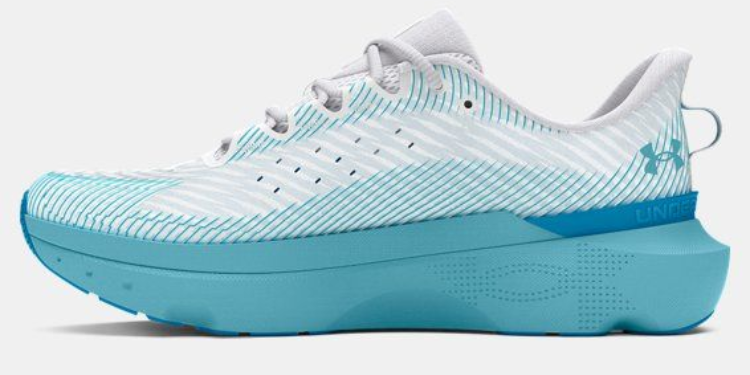 As you explore the landscape of smart running shoe developments, take a moment to gaze into the future of this dynamic industry. The smart running shoe market is poised for exciting advancements in tech features designed to further enhance user experience and athletic performance. These prospects include real-time coaching feedback directly from your running shoes, adaptive sole technology that adjusts to your unique stride, and comprehensive running data integration with other health and fitness metrics.
As you explore the landscape of smart running shoe developments, take a moment to gaze into the future of this dynamic industry. The smart running shoe market is poised for exciting advancements in tech features designed to further enhance user experience and athletic performance. These prospects include real-time coaching feedback directly from your running shoes, adaptive sole technology that adjusts to your unique stride, and comprehensive running data integration with other health and fitness metrics.
The potential for custom footwear goes beyond mere size and style customization as we navigate more profound into the era of 3D-printed footwear. Anticipate running shoes tailored to your biomechanics, ensuring each step is as efficient and comfortable as possible. This feature marks a substantial movement towards completely personalized running experiences, with dynamically adaptive cushioning and individualized support systems further enhancing comfort and performance. This technology isn’t just for professional athletes but anyone looking to optimize their physical health and running performance.
Moreover, the Internet of Things (IoT) is set to further revolutionize the smart running shoe. By enabling communication with other digital devices, your shoes could soon provide all-encompassing insights into your overall well-being. This represents the continued fusion of technology and footwear, impacting the athletic gear landscape as we know it. Rest assured, the future of running shoes and wearable tech trends sees the sports footwear market repeatedly reinventing itself to suit the evolving needs of modern users.
- Running Shoes Altra
- Running Shoes Reebok
- Running Shoes with Energy Return
- Running Shoes with Orthotic Compatibility
- Running Shoes for Overpronation
- Running Shoes with Stability
In conclusion, the evolution of running shoes has come a long way, from simple rubber soles to advanced innovative technology. These advancements have enhanced the runners’ performance and reduced the risk of injuries. The integration of wearable technology in running footwear has opened up new possibilities, providing valuable health and fitness information to the wearer. With features like shock absorption, ground contact time tracking, and foot strike angle analysis, these shoes can help every professional or recreational runner improve their athletic performance.
The future of running shoes looks promising, with continuous innovations and trends on the horizon. As we move forward, choosing the right pair of running shoes will not just be about fit and comfort but also about how smart they are.


